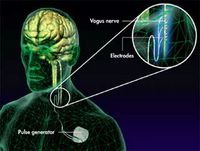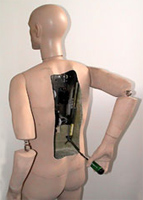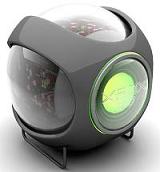 A small RFID chip will be attached to the drug label. To make the drug talk, users use an RFID reader which will match the information with a drug directory in a small database embedded in the reader.
A small RFID chip will be attached to the drug label. To make the drug talk, users use an RFID reader which will match the information with a drug directory in a small database embedded in the reader.
February 28, 2005
Talking Meds Tell Us How to Take Them
Thailand IC-Design Incubator is now developing a speaking drug label that will soon allow anyone to follow the instructions when taking medicine just by listening to the drug itself. The technology integrates RFID and voice recording to allow drug labels to tell the name of the medicine, give instructions on its use and information about its possible side effects.
 A small RFID chip will be attached to the drug label. To make the drug talk, users use an RFID reader which will match the information with a drug directory in a small database embedded in the reader.
A small RFID chip will be attached to the drug label. To make the drug talk, users use an RFID reader which will match the information with a drug directory in a small database embedded in the reader.
 A small RFID chip will be attached to the drug label. To make the drug talk, users use an RFID reader which will match the information with a drug directory in a small database embedded in the reader.
A small RFID chip will be attached to the drug label. To make the drug talk, users use an RFID reader which will match the information with a drug directory in a small database embedded in the reader.
Brain Pacemaker: Cure for Depression
 Scientists have developed a "brain pacemaker" that can cure depression by drilling holes into the skull and attaching electrodes to the brain which create a brighter mood.
Four women and two men had two electrodes planted into their brain to stimulate one of the areas involved in mood control. The other ends of the wires were threaded under the scalp down to the lower neck area. Next, the patients had a pulse generator implant, the "pacemaker", sewn in under the skin of their chest. The wires were hooked up to this to provide constant brain stimulation.
All six volunteers reported acute effects once the current was switched on. These included a sudden brightening of the room and a "disappearing of the void".
However, two of the six, lapsed back into depression within six months. But the scientists believe that fine-tuning the implant treatment could eventually cure most cases of severe depression. [Popular Science]
Scientists have developed a "brain pacemaker" that can cure depression by drilling holes into the skull and attaching electrodes to the brain which create a brighter mood.
Four women and two men had two electrodes planted into their brain to stimulate one of the areas involved in mood control. The other ends of the wires were threaded under the scalp down to the lower neck area. Next, the patients had a pulse generator implant, the "pacemaker", sewn in under the skin of their chest. The wires were hooked up to this to provide constant brain stimulation.
All six volunteers reported acute effects once the current was switched on. These included a sudden brightening of the room and a "disappearing of the void".
However, two of the six, lapsed back into depression within six months. But the scientists believe that fine-tuning the implant treatment could eventually cure most cases of severe depression. [Popular Science]
HUBO, Introduction of Human Type Robot
 A team led by professor Oh Jun-ho of the Mechanical Engineering department at KAIST held its first public demonstration of a walking human type robot called HUBO in the school’s Taewoolguan yesterday after three years of research. HUBO is shown bending 10 fingers with primary school children. During the show, HUBO danced and played games with spectators. HUBO measures 125cm and weighs 55kg, and can walk 30cm at a time (left and right strides: 15cm), and can turn itself at an angle of 45 degrees. It has 41 joints and motors all over its body allowing it various body movements. [Engadget]
A team led by professor Oh Jun-ho of the Mechanical Engineering department at KAIST held its first public demonstration of a walking human type robot called HUBO in the school’s Taewoolguan yesterday after three years of research. HUBO is shown bending 10 fingers with primary school children. During the show, HUBO danced and played games with spectators. HUBO measures 125cm and weighs 55kg, and can walk 30cm at a time (left and right strides: 15cm), and can turn itself at an angle of 45 degrees. It has 41 joints and motors all over its body allowing it various body movements. [Engadget]
Robotic Mannequin Spies on Consumers
 A Japanese firm has developed a mannequin robot that can follow your movement, strike a pose for you and spy on you and what you are buying.
A Japanese firm has developed a mannequin robot that can follow your movement, strike a pose for you and spy on you and what you are buying.
 The female robot codenamed Palette uses motion-capture technology to recreate the movements of supermodels. It caan also judge the age and sex of shoppers and even identify the bags they are carrying and pass the info along for marketing. She will be available in two versions, the whole body without legs or just the upper torso for jewelry displays. If well recepted, expect to see her with legs along with male and child models. Oh, and did I mention she has no face? The designer says this would distract from the items being modeled.
The female robot codenamed Palette uses motion-capture technology to recreate the movements of supermodels. It caan also judge the age and sex of shoppers and even identify the bags they are carrying and pass the info along for marketing. She will be available in two versions, the whole body without legs or just the upper torso for jewelry displays. If well recepted, expect to see her with legs along with male and child models. Oh, and did I mention she has no face? The designer says this would distract from the items being modeled.
Can you Bowl with the Xbox 360...
 If this turns out to be the design of the next Xbox, furniture makers are going to have to re-think their designs. If Microsoft wants to "own our living rooms", this is not the way. I mean come on, will this fit in with anybody's current home entertainment system? Maybe they will make some new round receivers and Tivos to match... geesh
If this turns out to be the design of the next Xbox, furniture makers are going to have to re-think their designs. If Microsoft wants to "own our living rooms", this is not the way. I mean come on, will this fit in with anybody's current home entertainment system? Maybe they will make some new round receivers and Tivos to match... geesh
iPod Camera Connector
 Last week's news about the iPod's upcoming camera connector looks to be real. However, it wouldn't take much for some of you hackers to make a cable with a iPod dock connector on one end and a usb port on the other would it? Could this open the door to tons of iPod hacks? If the iPod really does have USB-On-The-Go locked inside I'd say YES!
Last week's news about the iPod's upcoming camera connector looks to be real. However, it wouldn't take much for some of you hackers to make a cable with a iPod dock connector on one end and a usb port on the other would it? Could this open the door to tons of iPod hacks? If the iPod really does have USB-On-The-Go locked inside I'd say YES!
February 27, 2005
Dell dives into HDTV Market
Business strategy types often speak of "first mover advantage." The basic premise is pretty simple: The guy that gets there first has a better chance of winning. When it comes to new product categories, Dell is rarely, if ever, a first mover, and there's a simple reason: It doesn't have to be. What Dell is usually first at doing is bringing its formidable volume production and aggressive pricing model to bear on a market, giving most of its competitors fits.
HDTV is no exception for Dell. It has had several smallish LCD-based HDTVs on the market, but took its time bringing out larger displays, but now the wait is over. The company has two 42-inch plasma-based displays that it's selling direct from its Web site, true to Dell form. Both are competitively priced while maintaining a good level of quality.
The W4200 and the W4200HD are priced at $2,300 and $3,400, respectively. Both use PixelWorks' DNX video processors, and both employ Samsung panels. The difference is that the W4200 has EDTV resolution (852x480), while the W4200HD has a native resolution of 1024x768 with non-square pixels. We recently took the W4200HD for a test-drive and like the way it handled. If you're in the market for a flat-screen HDTV, should the W4200HD be on your short list?
The W4200HD has a native pixel resolution of 1024x768, so it isn't a true HD device, because it doesn't have enough pixels to draw a 1280x720 (720p) HDTV image. This is common among 42-inch PDPs, and to the W4200HD's credit, its PixelWorks video processor does a very good job scaling both 720p and 1080i HDTV images to fit its panel.
The W4200HD has two tuners built in, one of which is an ATSC over-the-the air HD tuner. Having a built-in ATSC tuner allows this set to display HDTV channels broadcast in your area, though you will need an antenna (not included). In addition to its generally solid performance, having the ATSC tuner built in is a big plus: A standalone ATSC tuner will set you back another $200 to $300.
So in the race to be a player in the 42-inch plasma panel HDTV market, Dell didn't get there first. But in taking its time, Dell has put together a good panel (from Samsung) with a good video processor (from PixelWorks), and combined that with two tuners (one of them ATSC) to produce a compelling plasma offering at $3,499. But there are a lot of 42-inch 1024x768 plasma panels on the market for under $3,000 now, and while we like the Dell, we're not sure that it will be able to command a $500-700 price premium versus other panels. The ATSC tuner is certainly a plus for the W4200HD, but a standalone ATSC tuner can be found for $300, so if a panel costs $2,700, you could get it and a standalone tuner, and still come out ahead.
For its performance and feature set, we do like the W4200HD, and it would make a solid addition to almost anyone's home entertainment center. But a less-expensive alternative might be the better way to go if you're trying to keep your HDTV acquisition cost below a set price ceiling. If you're okay with parting with more dollars to get a quality panel, the Dell will fit the bill. Just prepare yourself for a bigger bill to get that good fit.
Dell Computers Still not working with AMD
Dell has decided to continue their relationship with Intel and omit AMD from their computers. While I do see that AMD had gained some market "faith", I do believe that the majority of non-techie computer users still find Intel to be the chip they want inside their computer. What do you think?
Subscribe to:
Comments (Atom)